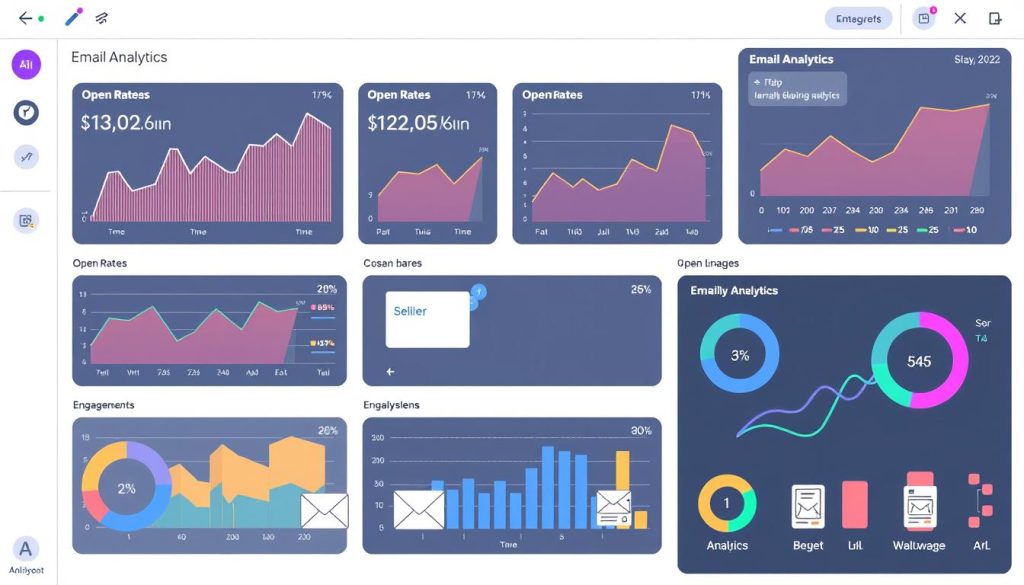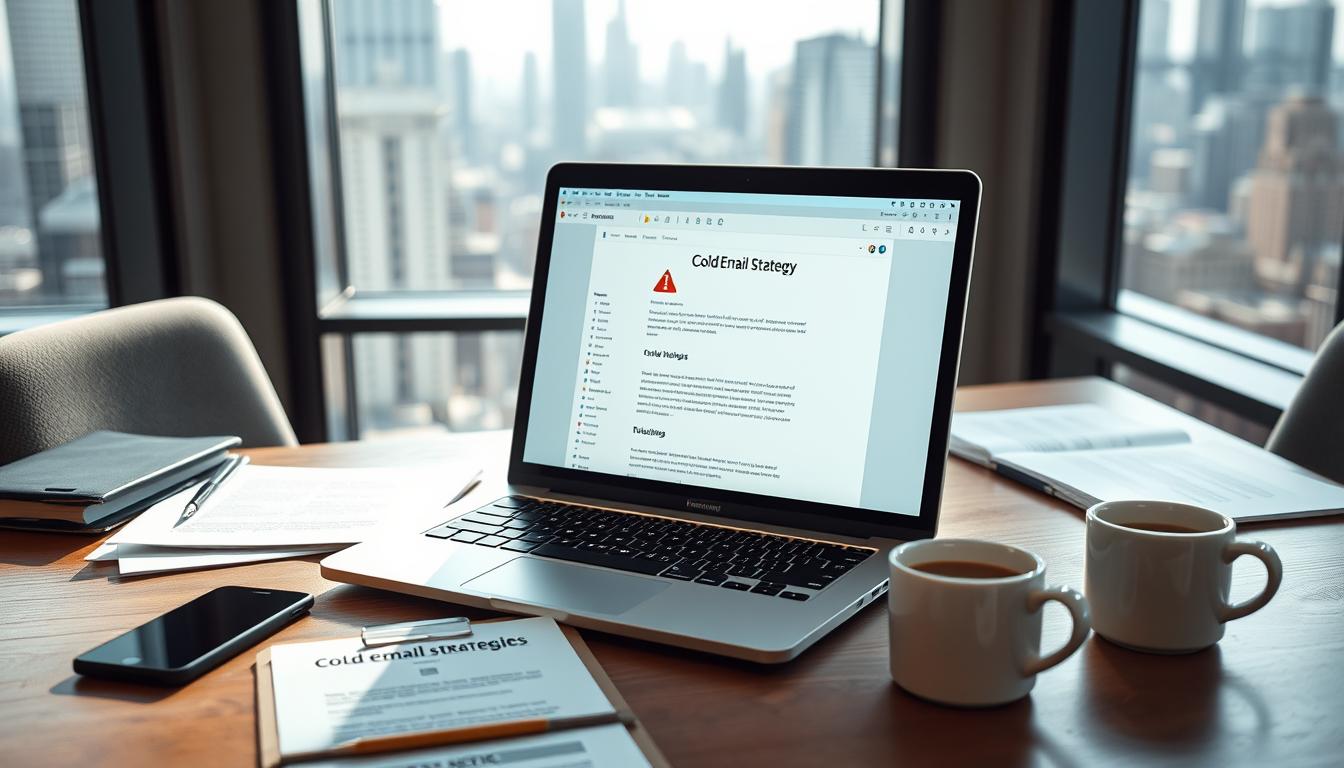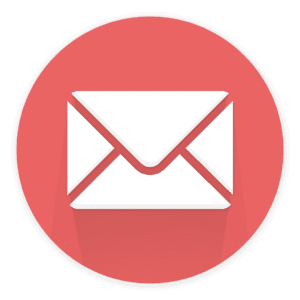In today’s fast-paced business world, cold emails are key for finding new clients. As a business broker, learning to write great cold emails can really help. It makes it easier to reach out to people who might be interested in your services.
This guide will show you advanced cold email tips for business brokers. We’ll talk about why cold emails are important, how to write catchy subject lines, and the importance of personal touches. We’ll also cover how to make a good email list, structure your emails, and when to send them for the best results.
By using these strategies and following email rules, you can improve your cold email campaigns. This will help you get more leads for your business. Let’s explore how to use cold emails to find new opportunities and succeed as a business broker.
Key Takeaways
- Understand the critical role of cold emails in generating leads and acquiring clients for business brokers
- Learn how to craft compelling subject lines that grab attention and increase open rates
- Discover the power of personalization in engaging prospects and building relationships
- Build targeted email lists and maintain list hygiene for effective outreach
- Structure your cold emails for maximum impact and include strong calls-to-action
- Optimize your email timing and follow-up strategy to maximize response rates
- Ensure compliance with email regulations such as the CAN-SPAM Act and GDPR
Understanding Cold Emails in the Brokerage Industry
In the fast-paced world of business brokerage, getting new leads is key to success. Brokers often use cold emails to reach out to potential clients. But what are cold emails, and why are they so important?
Cold emails are messages sent to people or businesses you’ve never contacted before. They aim to introduce your services and spark interest. This can help generate new leads for your brokerage business. Though some see cold emailing as intrusive, it can be very effective if done right.
What Are Cold Emails?
Cold emails are a way to start a conversation with potential clients. They’re different from warm emails, which go to people you already know. Cold emails target new prospects, aiming to grab their attention and show the value of your services.
Importance of Cold Emails for Brokers
For business brokers, cold emailing is a key part of getting new leads. It helps connect with potential clients who might be interested in buying or selling a business. By sending compelling messages, you can open up new opportunities and grow your client base.
“Cold emailing has been a game-changer for our brokerage. It allows us to reach a wider audience and start meaningful conversations with potential clients we may have never encountered otherwise.” – Samantha Thompson, Business Broker
Overcoming Initial Hesitations
One big challenge with cold emailing is getting past initial doubts. Many people are cautious of unsolicited emails and might see them as spam. To overcome this, personalize your messages, offer value, and show you genuinely care about helping them.
Think of cold emailing as starting a conversation, not just a sales pitch. By building trust and nurturing these relationships, you can turn hesitant prospects into loyal clients who trust your expertise.
Crafting the Perfect Subject Line
In the world of cold email outreach, the subject line is your first chance to grab attention. A good subject line can make a big difference. It can decide if your email gets opened or thrown away. Let’s look at how to make subject lines that grab attention and encourage people to read more.
Tips for Catchy Subject Lines
Here are some tips for your subject lines:
- Keep it short and sweet – aim for 6-10 words
- Use action-oriented language to create a sense of urgency
- Avoid spammy words like “free” or “discount”
- Pose a question or make a bold statement to pique curiosity
Importance of Personalization
Personalization is crucial for subject lines. Including the recipient’s name or company shows you’ve done your homework. In fact, personalized subject lines are 22.2% more likely to be opened than generic ones.
| Personalization Tactic | Open Rate Increase |
|---|---|
| Recipient’s Name | 14.7% |
| Company Name | 9.3% |
| Industry Mention | 5.1% |
A/B Testing for Subject Lines
To really improve your subject lines, try A/B testing. Send different subject lines to different groups of your email list. This way, you can see which ones work best. Over time, you’ll get better at writing effective subject lines.
“Your subject line is your first impression. Make it count.”
By focusing on catchy, personalized subject lines and using A/B testing, you’ll boost your cold email open rates. This will help your business brokerage succeed.
Personalization: The Key to Engagement
In the world of business brokerage, personalization is key for making effective cold emails. These emails engage potential clients and help generate leads. By making your messages fit the specific needs and interests of your audience, you grab their attention and get a positive response.
Studies show that personalized emails get 6x more responses than generic ones. This shows how important personalization is in making real connections with people and turning them into clients.
Techniques for Personalization
To personalize your cold emails, try these techniques:
- Use the recipient’s name in the subject line and greeting
- Reference their company, industry, or recent news
- Acknowledge their specific challenges or goals
- Offer tailored solutions or insights relevant to their situation
“Personalization is not about first/last name. It’s about relevant content.”
– Dan Jak
Leveraging Data for Better Targeting
To improve your personalization, use data for better targeting. Look at company size, industry, location, and key decision-makers. This helps you create targeted groups for your cold email campaigns.
Tools like LinkedIn Sales Navigator and ZoomInfo offer insights into your prospects. They help you make messages that are more relevant and compelling. By using data-driven targeting and thoughtful personalization, you can greatly improve your lead generation and build stronger connections with potential clients.
Building an Effective Email List
An email list is key for any cold email campaign’s success. By selecting the right leads, brokers can boost their chances of getting interest and closing deals. To build a good email list, you need to find leads, qualify them, and keep your list clean.
Where to Find Potential Leads
To create a strong email list, brokers should look at different places. These include:
- Industry-specific directories and databases
- Professional networking platforms like LinkedIn
- Referrals from existing clients and contacts
- Attendee lists from relevant conferences and events
By looking at many sources, brokers can make a list that reaches a wide range of potential clients.
Qualifying Your Email List
Not every lead is the same. To make their cold email campaigns better, brokers need to qualify their list. They should:
- Research each lead’s background and business
- Find out who makes decisions in the target companies
- Sort leads by industry, size, and other important factors
By focusing on high-quality, targeted leads, brokers can write emails that really speak to their audience.
Maintaining List Hygiene
Keeping your list clean is vital for cold email campaigns to succeed over time. Brokers should:
- Get rid of emails that don’t work
- Update contact info when it changes
- Watch how people interact with your emails to find unresponsive leads
A clean, up-to-date email list not only improves deliverability but also helps maintain a positive sender reputation.
By putting time and effort into a targeted, qualified, and well-kept email list, brokers can set up their cold email outreach for success. This leads to more leads and closed deals.
Structuring Your Cold Email
As a business broker, making a great cold email is key. It grabs the attention of potential clients and helps close deals. Knowing the parts of a good cold email and using best practices can really help.
Essential Components of a Cold Email
A good cold email has a few important parts:
- A catchy subject line to grab attention
- A personalized greeting showing you’ve done your homework
- A brief intro of yourself and your firm
- A clear, short value proposition
- Social proof or case studies to build trust
- A strong call-to-action to get the recipient to act
Best Practices for Email Length
When it comes to email length, shorter is better. A study by Boomerang found that emails between 50 and 125 words work best. They have the highest response rates, as shown in the table below:
| Email Length | Response Rate |
|---|---|
| 50-125 words | 51% |
| 125-200 words | 44% |
| 200+ words | 39% |
Keeping your emails short and to the point helps grab your audience’s attention. This increases your chances of success.
Effective Call-to-Action Techniques
Your call-to-action (CTA) is crucial. It tells the recipient what to do next. For business brokers, some good CTA techniques include:
- Asking for a quick call or meeting
- Offering a free consultation or business valuation
- Inviting them to an exclusive event or webinar
Make your CTA clear, specific, and easy to follow. By offering value and making it simple to act, you boost your chances of getting leads and closing deals.
“The key to crafting an effective cold email is to focus on the recipient’s needs and provide genuine value. By structuring your email strategically and using compelling calls-to-action, you can build trust and drive meaningful engagement with potential clients.”
– Jane Smith, Top-Performing Business Broker
Timing Your Cold Email Outreach
The success of your cold email campaigns depends a lot on email timing. Sending at the right time can boost your open and response rates. We’ll explore the best sending times for cold emails and share tips on follow-ups.

Optimal Sending Times
Research shows that Tuesdays and Thursdays are the best days to send cold emails. Mondays are bad because people are catching up, and Fridays are worse since they’re wrapping up. The best times are between 10 AM and 11 AM or 2 PM and 3 PM in the recipient’s time zone.
Think about your target audience’s work habits. For example, executives might check emails early in the morning. Adjust your email timing to fit your prospects for the best results.
“Timing is everything when it comes to cold emailing. Sending at the right moment can make all the difference in whether your message gets read or lost in a sea of emails.”
Frequency of Follow-Ups
Follow-ups are key in cold email strategies. Most people won’t respond right away, so you need to keep trying. But be careful not to be too pushy. Aim for 3-4 follow-ups over 2-3 weeks.
Space out your follow-ups to give people time to respond. A good sequence is:
- Initial email
- Follow-up 1 (3-4 days later)
- Follow-up 2 (7 days after the first follow-up)
- Final follow-up (7-10 days after the second follow-up)
Keep an eye on your email metrics and adjust your follow-up frequency as needed. If lots of people unsubscribe, slow down. Always add value and give people a reason to reply.
Writing Compelling Email Content
Creating effective cold emails for business brokers is all about the content. It’s key to grab the reader’s attention and get them to act. Think about the tone, language, and stories that will connect with your audience.
Tone and Language Considerations
The tone and language in your emails matter a lot. As a business broker, you want to be both professional and friendly. Use a tone that shows you’re confident and ready to help. Keep your language simple and clear, avoiding jargon.
Avoiding Jargon and Technical Terms
Remember, your readers might not know industry terms. You need to show you know your stuff without confusing them. Explain things simply and use examples to make your points clear.
Storytelling in Cold Emails
Storytelling is a great way to engage your readers. Use short stories or examples to show how you’ve helped others. Share success stories to make your message stick and persuade your readers.
“The best email content is the one that speaks directly to the recipient’s needs and desires. It’s about understanding their perspective and offering a solution that resonates with them.”
Your email’s goal is to grab attention, build trust, and encourage action. By focusing on tone, language, and storytelling, you can make your emails compelling. This will help you share your value and get results.
Following Up: Best Practices
Following up on your initial cold email is key to success. Business brokers who get follow-ups right can turn leads into clients. But, timing and how you write your follow-up emails are important to avoid being seen as pushy or unprofessional.
Timing Your Follow-Ups
The timing of your follow-ups is crucial. Sending one too soon can look desperate. Waiting too long might make your prospect forget about your email. A good rule is to wait 3-5 business days before your first follow-up.
If you don’t get a response, send a second follow-up after 5-7 more days. Remember, persistence is key, but avoid being spammy.
Crafting Follow-Up Emails
Here are some tips for writing your follow-up emails:
- Keep it brief and to the point
- Reiterate the main points from your initial email
- Offer additional value or insights
- Use a friendly yet professional tone
- Include a clear call-to-action
“Follow-up emails should add value to the conversation and gently nudge the prospect towards taking action.” – Samantha Jones, Successful Business Broker
When to Give Up
Not every prospect will respond to your follow-ups. Knowing when to move on is important. If you haven’t gotten a response after 3-4 follow-ups, it’s likely they’re not interested.
But don’t give up completely. You never know when they might become more open to your offer in the future.
Analyzing and Measuring Success
Sending out cold emails is just the start. To really improve your campaigns, you need to analyze and measure their success. Email analytics help you understand how your audience reacts to your messages.
Key Metrics to Track
Measuring your cold emails success involves tracking several key metrics:
- Open rates: The percentage of recipients who opened your email
- Click-through rates (CTR): The percentage of recipients who clicked on a link within your email
- Reply rates: The percentage of recipients who responded to your email
- Conversion rates: The percentage of recipients who took a desired action, such as scheduling a call or making a purchase

Tracking these metrics helps you see how your cold emails are doing. For example, low open rates might mean you need better subject lines. If CTRs are high but conversion rates are low, it’s time to improve your call-to-action or landing page.
Tools for Email Analytics
There are many tools to help with your email analytics. Some top choices include:
- HubSpot Sales Hub: Provides detailed analytics and reporting for your email campaigns
- Mailchimp: Offers a user-friendly interface for managing and analyzing email campaigns
- Mixmax: Integrates with your existing email client to provide real-time analytics and insights
By using email analytics, you can boost your cold email outreach. This leads to better success in your business brokerage efforts.
Remember, success measurement is an ongoing task. Regularly check your email analytics, make informed decisions, and keep improving your cold emails approach. This ensures you get the best results.
Compliance with Email Regulations
As a business broker, it’s key to know and follow email regulations. Not following these rules can lead to legal trouble and harm your reputation.
Brokers need to be aware of the CAN-SPAM Act in the U.S. and the GDPR in the EU. These laws aim to stop unwanted and misleading emails. They also protect people’s data.
Understanding the CAN-SPAM Act
The CAN-SPAM Act sets rules for business emails. It lets people choose not to get emails from you. To follow this law, brokers must:
- Make it easy for people to opt out of emails
- Stop sending emails to those who don’t want them within 10 days
- Include a real mailing address in every email
- Not use fake or misleading email headers or subjects
GDPR and Data Protection Considerations
The GDPR is for brokers who deal with EU people’s data. Under this rule, brokers must:
- Get clear consent before sending marketing emails
- Tell people how their data will be used
- Let people see, change, or delete their data
- Keep personal data safe
Following email rules is not optional. It’s a must to gain trust and avoid legal issues.
By following the CAN-SPAM Act, GDPR, and other data protection laws, brokers can make sure their emails work well and are legal.
Common Mistakes to Avoid
Cold emailing can be a powerful tool for business brokers. But, it’s crucial to do it with care and strategy. Many brokers make mistakes that can hurt their success and lead to failed campaigns. Knowing these pitfalls can help you improve your cold email outreach and get better results.
Pitfalls in Cold Emailing
One big mistake is not personalizing your messages. Generic emails are often ignored or marked as spam. Instead, research your prospects and tailor your emails to their specific needs and interests. Other common mistakes include:
- Focusing too much on yourself or your company, rather than the prospect’s needs
- Using a sales-heavy tone that can come across as pushy or aggressive
- Failing to provide value or a clear call-to-action
- Sending emails at the wrong time or with the wrong frequency
How to Learn from Failed Campaigns
Even experienced business brokers face failed cold email campaigns. The key is to learn from these experiences and improve future efforts. Here are steps to analyze and learn from a failed campaign:
| Step | Description |
|---|---|
| Review metrics | Look at open rates, click-through rates, and response rates to identify areas of weakness |
| Analyze content | Evaluate your subject lines, email copy, and calls-to-action to see what can be improved |
| Seek feedback | Ask colleagues or mentors to review your emails and provide constructive criticism |
| Test and iterate | Make changes based on your analysis and feedback, then test again to see if results improve |
“Failure is simply the opportunity to begin again, this time more intelligently.” – Henry Ford
By learning from your mistakes and refining your approach, you can create cold email campaigns that resonate with your prospects. This can drive real business results.
Real-Life Examples of Successful Cold Emails
Cold emailing is a key tool for business brokers to grow their network and find new leads. By looking at successful cold email campaigns, brokers can learn a lot. We’ll share examples of effective cold emails and what successful brokers have learned.
Case Studies of Effective Campaigns
Mark Thompson, an experienced business broker, landed a big deal with a cold email. His email showed he really got the prospect’s industry and what his services could do. Sarah Johnson also got a big client by making her email personal and relevant. These stories show how cold emails can help in business brokerage.
Lessons Learned from Successful Brokers
Successful brokers have picked up important lessons from their cold email campaigns. One big lesson is the value of doing your homework and making emails personal. This makes it more likely that people will respond. Another key lesson is the power of a good story in your email. It grabs attention and builds a connection.
Brokers also know that following up is crucial. By sending follow-up emails at the right time and adding value, they can build stronger relationships. This increases the chance of getting a positive response.
By studying these examples and lessons, business brokers can improve their cold email strategies. Remember, making great cold emails takes research, personal touches, storytelling, and persistence. By using these tips and learning from others, brokers can make the most of cold emailing in their business growth.






